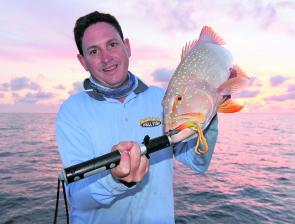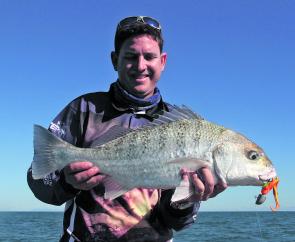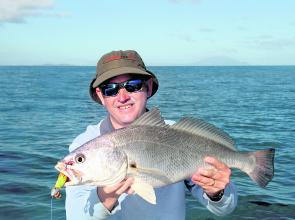Many offshore anglers believe in the saying that offshore fishermen are only as good as their fishing spots. As a result, it’s often the fishing spot or the skipper’s collection of secret marks which get the credit for a sensational catch.
However, more often than not these sensational catches don’t come from utopian honey holes filled to the brim with fish but from commonly known reefs, shoals and islands. The real secret is sometimes not where you are fishing but how you are fishing and, most importantly, what sets you apart from the other anglers fishing the same piece of ground.
One important thing to remember is that fish systems don’t necessarily become devoid of life because they have been ‘fished out’. Often there are still plenty of fish on these spots, they just become a little harder to catch because of the pressure placed upon them. Many offshore anglers prep for a trip by grabbing the characteristic slab of pillies and squid, and on some occasions that’s enough to bag a few fish. However, when the majority of people are doing the same thing, the fish can get used to it and wise up. It’s at times like these that you need to think outside the box. It’s amazing how often discarded old grounds or marks can be transformed into new productive ground with the application of a different technique.
The easiest way to step it up and move away from the mainstream is to jig soft plastics. You would be amazed at what fish you can pull off a mark using soft plastics. On recent trip I was drift fishing a well known wreck using a Berkley Squid Vicious while the boys around me were using standard baits of cuttlefish, slabbed yakka and pilchards. The first drift saw not a single bite on the bait but the plastic snared a beautiful 4kg coral trout. Resetting the drift again the baits once again failed to hook up, but the plastic this time was inhaled by another coral trout, much to the disgust of the boys around me.
We continued this process for six more drifts which produced a few small nannygai for the bait boys while the plastic snared a golden snapper (fingermark) and finally a personal best 7kg bar-cheek trout. One of the guys on board had been fishing this spot for over 10 years and had never pulled a trout off it.
When I tell bait fishers where we caught the fish, most refuse to believe me as this ‘old ground’ produces little to nothing using traditional techniques. This has not been a once-off event either. Much of the older discarded ground, often driven over in the pursuit of further offshore marks, has been consistently producing trophy fish.
The reason is a simple one: many of these older spots have seen little exposure to soft plastics compared to bait-filled hooks, so plastics are more likely to snare wary fish. While you could also say that soft plastics resemble live bait, I also believe that the plastics’ uniqueness grabs fishes’ attention. This is especially the case with coral trout, golden snapper, and even reds which are very inquisitive and territorial and will always come out to investigate something new and different.
Soft plastics give you plenty of variety as well. If you know your local fish feed on small baitfish or slimies then use a large jerk shad pattern, or for fish that prefer squid you can use something which has dangling appendages.
The key to fishing soft plastics is persistence. It’s hard to sit back and watch anglers around you getting a bite or pulling in a fish while your soft plastic remains untouched. However, you can rest assured that when it goes you will be the envy of everyone on board.
Metal jigs are also very effective and you would be shocked at some of the species of fish which will slam a worked metal.
The soft plastic itself is not just the only adjustment you can make to separate yourself from the rest. The weight of the jighead is also important. Weight will dictate the way the plastic is fished and the action it brings. For trout, a heavy weight is preferable as you want to bang the plastic on the bottom to stir them up and get them out to investigate. For snapper, however, most anglers prefer as light as possible to get the softy dancing in the water.
Finding the right weight is as easy as recognising the speed of your sink. If you are hitting the bottom with pace and can really feel the jighead thump down, you are fishing heavy. Alternatively, if the connection to the bottom is mild and hard to register, you are fishing light. When chasing fish which prefer light weights you don’t really want to be on the bottom anyway, as you will get the majority of your fish as the plastic drifts down or is suspended a couple of metres off the bottom.
Once again it’s about persistence and finding the pattern of where your fish feed and what type of weight they prefer. Once you get this sorted out you will be amazed at the rewards.
If you just can’t get yourself into soft plastics fishing, the best way to spice it up is to add more attraction to your baits. The best way to do this is to use fly-style hooks which provide plenty of flash to a bait. Some of the best examples of these come from the guys from PE Tackle which incorporate some awesome fly patterns on heavy-duty hooks which are perfectly suited for snapper, grunter, reds and trout. The fly style designs provide the best of both worlds and really do make baits stand out from the rest.
Anchoring can be effective, especially if you find a school of fish or get your hang perfect over a single structure, but you also run the risk of limiting your fishing ground. I like drifting, but the decision is often determined by the structure being fished. I prefer to drift even on the smallest of lumps or wrecks as you cover more ground and more often than not the larger trophy fish are holed up on smaller rocks or reef away from the structure. This is because these bigger structures can be dominated by big groper, cobia and cod which will just as readily eat a 60cm snapper or trout as a yakka.
Drifting really suits soft plastic fishing, as the movement helps with the action of the plastic. Plastics rigged on jigheads are much less prone to snags, especially over the reef, compared to paternosters and other hook/sinker combos.
If you are drifting and not getting results, think about how you are presenting your baits and whether they are finding the pressure points or the front of bommies and into the strike zone. Try mixing up your drift directions until you get results. You never know when currents are sweeping your soft plastics out of the zone, even though the sounder may be showing the perfect drift, especially when fishing light. You should try to take something away from every drift and try something new until it works.
It’s surprising how something as simple as the width and strength of your leader and line can affect finicky fish on heavily fished spots. How often have you stood next to someone who has pulled in fish after fish and you can’t figure out what’s going on? It’s quite possible they are fishing lighter leader and line, which affects the way the bait or soft plastic is being presented, and most importantly how visible it is to the fish.
For example, at one of my favourite golden snapper spots you can fish all day using 30lb+ leader and not catch a thing. Drop down to 15lb and you will be in the thick of it!. When fishing old ground you have to give a bit and going as light as possible is really important. A good starting point is to halve the leader you would normally use. If you’re worried about getting busted up, invest in some quality leader which will give you plenty of strength and abrasiveness even at the lower ends of the spectrum. Good examples of this include Sunline FC100 and FC Rock, which are light enough but strong enough to withstand plenty of power.
The reality facing all offshore anglers is that there are more and more of us every year. Where you used to see three or four boats on a good day you might now see 15 or more – and with the invention of GPS, radar and loose lips, it’s hard to find any new ground anymore. Finding a way to fish around this pressure is essential if you want to enjoy success. You may even be surprised at just what you can pull off that discarded piece of reef or shoal that people thought was fished out.
Reads: 1704
Having a selection of soft plastics, soft vibes and an array of different weighted jigheads provides buckets of opportunity to turn old ground into new.

The author with one of many big trout taken from what other anglers saw as ‘old ground’.

You’ll be amazed at what you will pull off older ground when fusing soft plastics, light lines and a drift pattern. This solid grunter was taken on a spot which had never produced grunter before.

Joe with a healthy snapper landed using PE Tackle fly gear. If you can’t make the transition to plastics, spicing up your baits can make a huge difference and can give you that edge over your fellow anglers.

The author with a solid black jew taken on soft plastic. This species is often picked up on the drift as anchors can scare them off the bite.

Golden snapper are notorious for being picky and hard to catch, sometimes demanding nothing less than a live bait. However, fishing light and using soft plastics is often enough to get the fish to bite.

Big reds like this one often hang amongst smaller fish. Trying something different is often what it takes to entice the larger fish from the pack.

Soft plastics are terrific for stirring up big trout which have become weary of bait-filled hooks.




